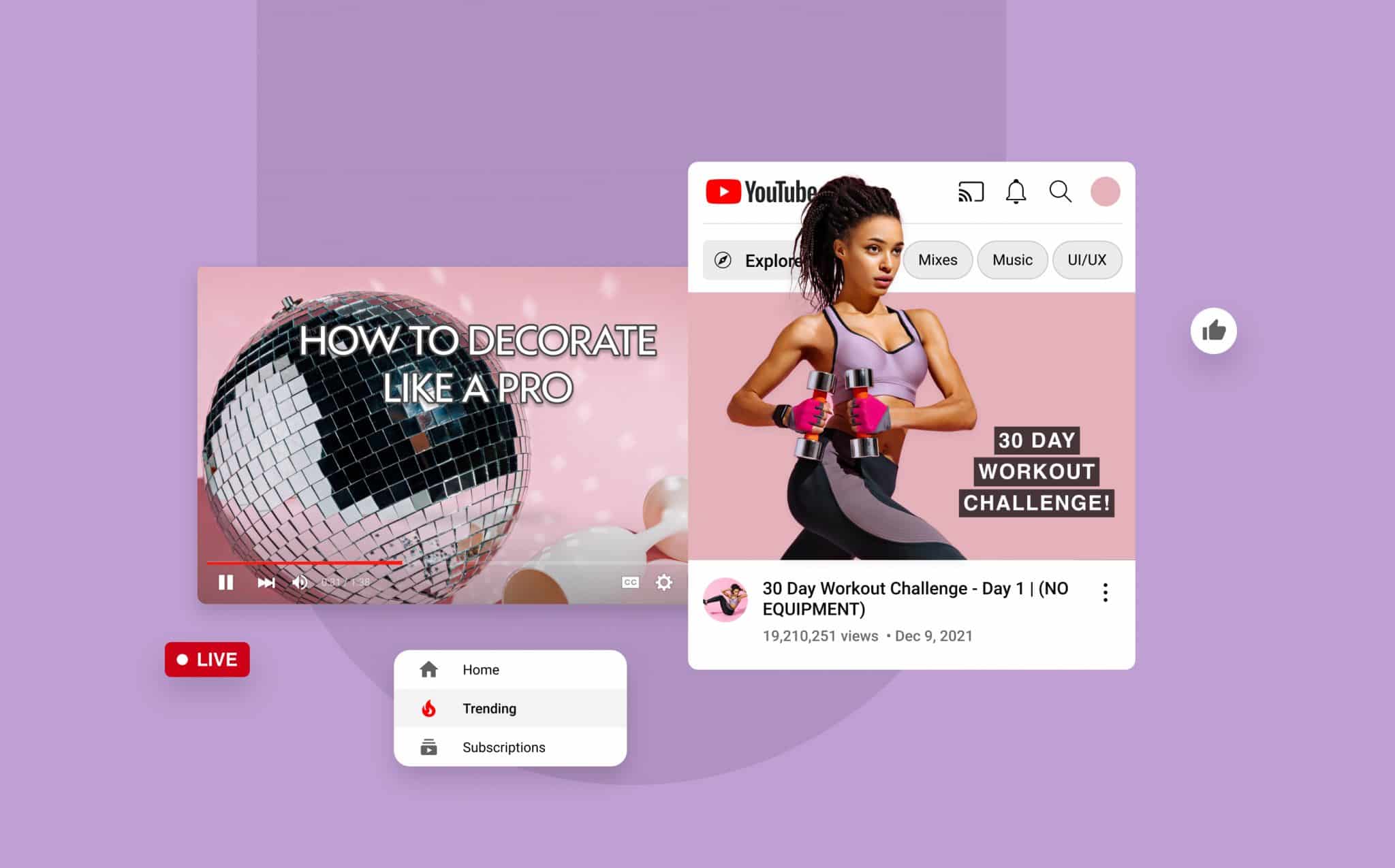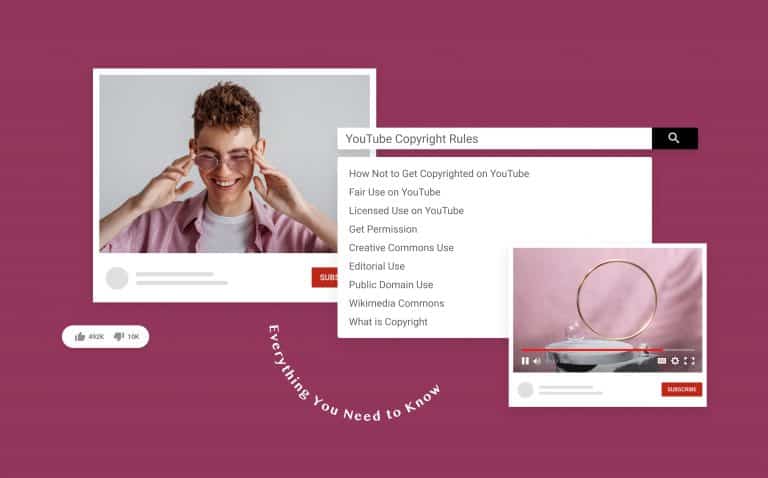
An Introduction to YouTube Trends and How They Can Help Grow Your Channel
YouTube trends are constantly evolving. Viewers have access to more videos than ever before, so if you want your content to stand out, it’s important to monitor YouTube trends to know your audience’s interests. Not only that, you’d have to align your content to meet their ever-changing needs.
But how do you monitor these YouTube trends and use them to your advantage? That’s what this article is all about. We will show you how to leverage valuable insights from YouTube trends to make videos your audiences love to watch and boost visibility for your business.
Let’s get to it.
What are YouTube Trends?
No doubt you have been exposed to or heard the term “trending” in relation to social media networks. Particularly on social networks like Twitter and LinkedIn. Trending is a word used to describe what’s currently popular with the users of any particular platform – and YouTube trends are not any different. YouTube video creators can improve their marketing by zeroing in on the latest fads.
The YouTube Trending page regularly showcases the latest trending videos on YouTube based on your geographical location. This means that YouTube content creators and users can access a daily resource of metrics (what’s trending) to gain insight into what’s going on within the world of video consumption on the web.
The YouTube Trending page showcases popular videos in real-time and offers tabs for specific categories such as Now (what is trending currently), Music (what is trending in the Music on YouTube), Gaming, and Movies. In addition, the YouTube Trending page is where users and creators alike can identify and understand trends across the YouTube platform.
But YouTube trends are not only related to the trending page. While the trending page gives insight on the kind of content users are looking consume, you should have an eye out for platform updates and changes to discover evolving formats and usage trends.
Leveraging YouTube Trends
As viewers embrace emerging trends, their behavior is changing fast. These rapid changes mean YouTube marketers must understand what viewers want and try to deliver content that can answer their needs.
But how do you know what interests your YouTube audiences?
One of the ways customers communicate the things that interest them is through YouTube search queries, likes, dislikes, Not Interested, and survey feedback.
YouTube algorithms capture this information from more than 2 billion users worldwide, making it an invaluable source of insight into consumer interests, preferences, intent, and behavior.
YouTube search trends reflect customer intent and behavior. Hence, they can help inform your overall marketing strategy. In addition, these insights (trends and changing tastes) can provide helpful information to support other marketing decisions, such as:
- What social media channels you should use
- The type of videos that will appeal to your audiences
- How often you should share content on these social channels etc
For example, there’s been a growing appetite for short-form videos on social platforms like TikTok and Instagram Reels.
According to eMarketer, over 75% of US adults spend an average of two hours viewing short-form videos daily.
In response to this new trend, YouTube introduced YouTube Shorts. The platform is currently enjoying massive adoption of these short reel videos while in its beta phase. Since its launch in 2020, YouTube Shorts has already surpassed 6.5 billion daily views.
With online mobile video consumption hitting the roof, YouTube has launched many other features like live streaming to enable users to binge exciting videos on the go. This is just proof of how viewers quickly adopt emerging trends, and keeping up with them could benefit your brand.
By diving deeper into YouTube trends analytics, you can uncover a wealth of data like keywords, topics, consumer behaviors. And leveraging these insights will help you with the following aspects of managing your channel:
- Create timely, trendy, and relevant video content that resonates with most viewers
- Improve YouTube ranking and increase your brand visibility,
- Review and optimize our YouTube and video marketing strategy
- Stay ahead of your competition and more
Understanding The YouTube Algorithm
With over a billion hours of YouTube videos watched every day, you might wonder how YouTube recommends videos to viewers or ranks them. YouTube’s algorithm or recommendation system leverages AI to find and suggest videos users would like to watch. By helping viewers find videos that resonate with them, YouTube can drive engagement and satisfy viewers.
The algorithm serves relevant and personalized videos in different sections of YouTube, including:
- Search
- Home Page
- Suggested Videos
- Trending
- Subscriptions and
- Notifications
By understanding YouTube algorithms and trends, you can create appealing content, boost your ranking and get more eyes on your video. Before we dive into more details about the YouTube algorithm, let’s take a brief look at how it has evolved over the years.
How YouTube Algorithm Has Evolved
From YouTube’s launch in 2005 till 2011, the algorithm favored videos according to the number of clicks and views. This meant that even low-quality videos could rank higher if they attracted enough engagement.
Around 2012, YouTube changed the algorithm to recommend videos with a higher completion rate. The general assumption was that people are more likely to watch valuable and interesting content till the end.
However, you’ll agree that time spent on video or platform doesn’t directly translate to valuable time spent. Optimizing for watch time wasn’t an accurate measurement of quality. That’s because some content creators could easily adjust video length to boost the completion rate.
Although watch time still plays a role in YouTube’s recommendation system, Google updated the algorithm in 2015 to support videos that benefit and satisfy viewers.
YouTube’s algorithm (Rankbrain) uses different signals like viewer surveys and engagement metrics such as likes, dislikes, and the “Not Interested” button to measure viewer satisfaction. The algorithm then recommends watch-worthy videos to viewers based on:
- Engagements and viewer’s feedback
- Viewer’s past activity
- The video’s overall performance and more
From 2016 till date, YouTube’s content moderation has been a hot topic attracting media and government interest. As a result, YouTube aims to make the platform safe, enjoyable, and valuable for users.
How Does the YouTube Algorithm Work in 2022?
The YouTube algorithm recommends relevant and personalized videos using different metrics and ranking systems such as:
- Personalization (viewer’s watch history and preferences)
- Performance (the video’s engagement, appeal, and success)
- Keyword relevance and
- External factors (interests, competition, and market)
If you want to optimize your videos for the YouTube algorithm, make videos that your viewers will love and use relevant keywords. By doing this, your content will check all the boxes in terms of likes, views, completion rate, ranking, and etc.
Let’s take a detailed look at the main factors considered by the YouTube algorithm.
Performance
When a new user visits YouTube, the algorithm serves up videos that it thinks they might like. These recommendations are often generic because the algorithm hasn’t yet figured out the viewers’ preferences, i.e., news, sports, music, or comedy.
At this point, the algorithm recommends YouTube videos that have performed well with other viewers, as well as measuring video performances using metrics. The following are few of the metrics they look at:
- Watch time or average view duration
- Click-through rate
- Average percentage viewed
- Likes and dislikes,
- Viewer surveys
When you upload a video, the algorithm recommends it to a few users on their YouTube suggested videos page or homepage.
When your videos resonate with them, they will like, comment, or watch them to the end. As a result, YouTube will tag it as useful content and recommend it to more people on their homepage.
YouTube’s Trending page also ranks videos based on performance, view count, and how these views have grown over time.
Do you want to increase your ranking on the trending and the homepage sections? Then start by creating striking thumbnails that entice your viewers to click your video. Once you’ve attracted their attention, you can engage them by creating content that keeps them coming back for more.
Not only will this increase your video watch time, but it will generate viewer satisfaction signals and boost your YouTube channel rankings.
Pro Tip: You can use YouTube Trends analytics to understand what topics and interests matter to your audiences. Once done, go ahead and create captivating content that entices viewers to watch, like, and share your video.
Personalization
As viewers begin to engage with content, the YouTube algorithm pays strict attention to how they interact with the content. Here are some things YouTube looks out for:
- What users watch and don’t watch
- The amount of time your viewers spend watching these videos
- Videos they like, dislike, and aren’t interested in based on their feedback
By tracking viewer’s activities, watch history, and preferences, the algorithm can recommend videos that are relevant to their interests that show up on the homepage results and suggested videos page.
For instance, if you watch more videos or channels about cars, YouTube will suggest similar videos or channels about that topic or interest.
Keep in mind that user behavior isn’t static and could adjust to trends. Therefore, the YouTube algorithm constantly monitors these changes and recommends content that aligns with viewers’ interests over time.
The beautiful thing about monitoring YouTube video trends is that it keeps you ahead of the curve. Once you understand how your audience’s interests and affinities rise and fade, do these things.
- Create content that appeals to their changing needs and keep them hooked into your channel
- Build massive followership by responding to comments and feedback about these topics
External Factors
As a content creator, remember that there are other factors that play into different ranking signals that are beyond your control that could impact your YouTube video ranking. These external factors could range from topic interest to competition to seasonality.
Topic Interest
Some topics have more exposure, audience sizes, and engagements than others. Let’s say you’re creating videos about a niche topic like pets, cooking, or travel. You could get more views, likes, and shares. But for unpopular topics like Non Fungible Tokens (NFTs), you may have to deal with limited exposure or lack of widespread interest. Here we take a look at what that means.
Seasonality and Trends
Topic interest often changes with seasonal trends. For example, Xmas videos are more popular during Christmas. And you’ll probably find more outdoor videos in the summer.
Viewership could fluctuate at different times during the week and year. For instance, viewers’ schedules change around September as schools resume. And creators also record declines in views within the week and a surge during weekends.
Competition
Google says the number of YouTube channels with over 1 billion views has grown by five times over the past three years. This means many YouTube videos and channels are competing with yours.
Therefore, the amount of time your viewers spend watching content from other channels can impact how much YouTube recommends your content to them.
Although these factors are outside your control, here’s what you can do to keep video engagements over the top.
- If you notice a drop in engagement at different seasons, that could be an excellent time to try something new with your content. Monitor YouTube searches to know what people are searching for. In addition, follow trends on YouTube to know the hot topics in other regions.
- Keep experimenting with your content as peoples’ interests change over time. Producing content that aligns with trends, seasons, and interests could bring a jump in impressions and engagement.
Keyword Relevance
According to YouTube, the homepage and suggested video algorithms are the top traffic sources for marketers. However, YouTube searches also have considerable traffic for explainer and instructional videos.
When it comes to search, the YouTube algorithm doesn’t just rely on video performance. Keyword relevance is also a key ranking signal.
Keywords help determine videos that are relevant and useful to users’ search queries. The YouTube search algorithm doesn’t scan your video to know what it is about. Rather it relies on the keywords in your video’s metadata to get this information.
If you want your video to rank higher for search result pages, use relevant keywords in your video metadata (titles, descriptions, captions, etc.).
One way to uncover popular search queries is by monitoring YouTube trends. For instance, the YouTube section of Google Trends can give you an insight into popular YouTube search terms in different locations.
You can also use other tools like Google AdWords, SEMRush, and Moz to find useful keywords.
How Does YouTube Recommend Videos?
YouTube’s recommendation system pulls in video content based on viewers’ watch history, preferences, performances, and other external factors. However, when it comes to trending videos, the algorithm considers other factors beyond performance.
YouTube’s Trending page shows viewers what’s happening on YouTube and around the globe in real-time. The algorithms pull in a wide range of cool, fun, and interesting videos worldwide that viewers would love.
If you’d like to know the most searched thing on YouTube today, go to the Trending page found under the Explore Tab and scroll through.
Some trends like new movie trailers or new songs from famous artists could be predictable. But at other times, it could be hot stories, viral videos or breaking news, etc.
Unlike the home page or suggested videos, the Trending page isn’t personalized. Therefore it shows the list of trending videos in each country to all viewers.
This means that everyone in the US will see the same trending video list. Also, the trending video list will be different for the UK or Spanish viewers and vice versa.
YouTube updates the list of trending videos every 15 minutes. And with each update, videos could remain in the same position or move up and down the trending list.
With the sea of incredible content on YouTube, you might wonder. How does the YouTube algorithm work or determine which video will rank on the Trending page?
Given that the Trending page can only display a limited number of videos, it aims to show videos that:
- Appeal to a broad range of viewers
- Are not misleading, deceptive, clickbaity and sensational
- Capture the breadth entirety of what’s happening on YouTube and worldwide
- Showcases a diverse range of creators
- Are engaging, surprising, or novel
To aggregate content that meet the above criteria, the YouTube Trending algorithm uses different considerations and ranking signals, including:
- View count
- Temperature (How quickly the video is generating views)
- The age of the video
- Where views are originating from, including outside of YouTube
- The video’s performance compared to other recent uploads from the same channel
Together, these signals produce a list of videos that reflect what’s trending on YouTube and around the world.
YouTube takes the safety of what appears on the Trending page very seriously. Consequently, they have filters to ensure viewers aren’t exposed to videos that contain violence, excessive profanity, mature content, and other inappropriate content.
How To Use YouTube Algorithm to Rank on the Trending Page
As earlier mentioned, YouTube showcases videos relevant to our viewers based on various signals. This means the most popular videos on a given day aren’t guaranteed top spots always.
For example, the video with the highest number of views may not be #1 on Trending. Also, videos with more views could appear below videos with fewer views.
Since YouTube doesn’t favor specific creators or accept payments for ad placements on Trending, so creators have a level playing field.
To gain the top spot on the Trending page, here’s how you can use the YouTube algorithm to your advantage.
1. View Count
Videos that amass multiple views have a better chance of making it to the top of the Trending page.
Whether you’re a brand or marketer, focus on making high-performing content. This can help improve your ranking on the Trending page, the YouTube Homepage, and Suggested Videos page.
For example, in the music category on Trending, you’ll mostly find videos with over 100,000 views. Reaching the top of the YouTube Trending page shows how well these videos have performed in terms of views, likes, and comments.
2. Viewing Trends
Another important criterion for ranking on Trending is how quickly the video generates views.
For example, the movie trailer Spider-Man: No Way Home has over 53 million views just three weeks after release. This impressive YouTube viewing trend indicates that the video is valuable to a broad audience in Spain, the US, and the UK.
Therefore, the YouTube algorithm will recommend it to other viewers on the Trending page, Homepage, and suggested video page.
3. Origin of Views
Getting views from multiple sources, including outside of YouTube, can boost your ranking and up your chances of success.
Views from multiple sources show that your content is high-quality and useful for a large audience, even beyond YouTube audiences. Depending on your strategy, you can attract more views and subscriptions, and engagements from other sources by:
- Embedding your videos on your blog or website
- Cross promoting your content on multiple social media platforms like Twitter, Facebook, LinkedIn
- Partnerships with other channels, influencers, and brands, etc
4. The Age of Your Video
The YouTube Trending tab displays what is happening in real-time, so the algorithm favors fresh, engaging, and watch-worthy content.
Even if your older videos are getting more traffic, newer videos that align with current trends will rank higher. Therefore consider releasing trend-worthy content frequently.
5. Relative Performance to Your Other Videos
It’s not enough to have individual videos that perform well. Make sure that other recent uploads from your channel earn a lot of views and engagements.
Although the YouTube algorithm relies on the audience and video-level signals to recommend to viewers, other under-performing videos on your channel could hurt your ranking.
For example, let’s say viewers decline most of your videos from YouTube recommendations. That could result in a decline in overall channel views and ranking.
Since YouTube trends are specific to each country, it captures the overall mood of the market, including:
- Demographics (gender and age groups)
- Consumption habits (devices, genres, etc.)
- Preferred content type
- Seasonal trends and competition
Therefore, you can adopt a more focused approach to making videos that resonate with your niche, audience, or market and keep your channel growing.
To boost your video ranking, you must first establish a strong visual identity. Promo.com offers a wide range of templates, design elements, filters, effects, and features to help you create captivating videos that attract more views and more subscribers.
How To Find What’s Trending on YouTube
Every day, millions of people turn to YouTube for videos that cater to their diverse interests, needs, and passions. There are a lot of resources and tools you can use to uncover the latest, real-time data about viewers and trending topics on YouTube, here is a quick look at some of them:
- YouTube Trending dashboard
- Google Trends for YouTube
- YouTube Analytics Tools
Let’s look at how to use these YouTube trend analytics tools.
Approach #1: YouTube Trending Dashboard
The YouTube trends dashboard displays a feed of popular trending videos specific to the viewer’s country. You can access it by clicking the Explore on the sidebar and then Trending.
Trending videos are split into four categories: Now, Music, Gaming, and Movies. So you can check out the latest comedy clips, music clips, viral videos, movie trailers, and what people are watching on YouTube in a specific country.
Users can change countries to see what’s happening in other countries. And since the dashboard updates roughly every 15 minutes, videos may change or stay in the same position.
Approach #2: Google Trends for YouTube
Google Trends for YouTube analyzes the YouTube search trends, queries, and topics across various regions.
It gives you a deeper insight into the search behavior of viewers, specific topics, and queries they are searching for in real-time.
Once you visit the website, you can explore curated insights about trending topics on YouTube and understand how people search for different themes.
In addition, you can explore and gauge your interest in any topic or search term. Next, you can filter data by periods, categories, and geographic locations.
The tool lets users compare multiple search terms to determine the following:
- How interests in different search terms have evolved
- Interests by region (regions where the search term is most popular)
- Related topics and queries etc
With this tool, marketers and brands can understand how viewers’ needs evolve and quickly adapt as market dynamics change rapidly.
For example, let’s say you want to find out what’s been trending in the games niche in the past month on YouTube. Using filters will reveal trending topics and search terms related to that topic.
You can narrow your search by time to determine if the trending topics or search terms are steady, seasonal, or caused by isolated events. Armed with this information, you can create videos or target YouTube ads to meet your viewers’ needs.
Approach #3: YouTube Analytics Tools
If you’re looking to optimize your YouTube videos for SEO or boost ranking, you can use the following analytics tools:
These tools leverage the power of AI to make YouTube SEO optimization and marketing a breeze. They provide deep insights into how you can keep your YouTube audience and channel growing.
With these YouTube analytics tools, brands and content creators can:
- Check new and seasonal trends on YouTube
- Measure and analyze their YouTube profiles to make strategic decisions about ad spend and marketing campaigns
- Discover video ideas that could make their channel pop
- Track and compare real-time performance (including reach, impressions, clicks, and other engagement metrics), rake in more views, and make money from their content
- Discover keywords, titles, and descriptions that will boost your YouTube views and get you more subscribers
Parting Words on YouTube Trends for Your Business
There you go. YouTube isn’t just a video marketing platform. It’s a robust search engine with rich data and valuable insight that brands and creators can tap into. By using analytics tools, you can gather useful information such as hot topics, who your viewers are, what they’re watching, and interested in.
Now that you know to find out what’s trending and YouTube trends to look out for in 2022, it’s time to put it to work. Take advantage of the deep insights from YouTube trends and search data to:
- Create videos your audience love to watch
- Increase video engagements (likes, comments, and shares) and
- Get your brand in front of more people
The last thing you want to have is distorted or poor-quality videos on your channel. Thankfully, Promo.com has everything you need to create stunning videos and build engaging YouTube channels in minutes.



